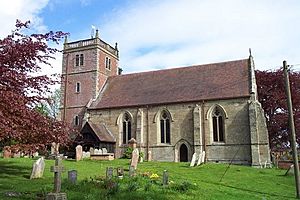St Peter's Church, Chelmarsh facts for kids
Quick facts for kids St Peter's Church, Chelmarsh |
|
|---|---|

St Peter's Church, Chelmarsh, from the south
|
|
| Lua error in Module:Location_map at line 420: attempt to index field 'wikibase' (a nil value). | |
| OS grid reference | SO 721 879 |
| Location | Chelmarsh, Shropshire |
| Country | England |
| Denomination | Anglican |
| Website | St Peter, Chelmarsh |
| History | |
| Status | Parish church |
| Architecture | |
| Functional status | Active |
| Heritage designation | Grade I |
| Designated | 9 March 1970 |
| Architect(s) | J. Farmer (porch) |
| Architectural type | Church |
| Style | Norman, Gothic, Neoclassical |
| Specifications | |
| Materials | Stone and brick |
| Administration | |
| Parish | Chelmarsh |
| Deanery | Bridgnorth |
| Archdeaconry | Ludlow |
| Diocese | Hereford |
| Province | Canterbury |
St Peter's Church is a beautiful old church located in the village of Chelmarsh, Shropshire, England. It's an active Anglican church, which means it's part of the Church of England. This church is very important. It is listed as a Grade I building in the National Heritage List for England. This means it's a building of exceptional historical interest.
Contents
History of the Church
The main part of St Peter's Church was built in the 1300s. It replaced an even older church that stood on the same spot. This new church was likely finished by 1345. Around that time, a special chapel was added by Hugh de Mortimer. This chapel was for prayers for the dead.
The lower part of the church's tall tower was also built in the 1300s. The top part of the tower was added much later, around 1720. The south porch, which is like a covered entrance, was built in 1887. It was designed by an architect named J. Farmer.
What the Church Looks Like
The main part of the church is made of stone. It is built in a style called Decorated Gothic. This style was popular in England during the 13th and 14th centuries. You can see an older doorway from the original Norman church. This doorway was moved and placed in the north wall.
The upper parts of the tower are made of brick with stone details. They are in a Neoclassical style, which was popular in the 1700s. The tower has a doorway on the west side. Above this door is a window with three sections. The tower also has strong supports called buttresses. It has alternating stone blocks called quoins at its corners. At the very top, there are bell openings and a decorative railing called a balustrade.
On the south side of the church, you'll find the porch. There's also a special doorway for the priest. You can see three tall windows with two sections each. The large east window has five sections.
Inside the Church
Inside, the church has a row of arches called an arcade. This arcade has four sections and is supported by eight-sided pillars.
The stained glass in the east window is from 1892. It was designed by an artist named Charles Eamer Kempe. This beautiful window shows the Crucifixion, which is a scene from the Bible. In the south window of the chancel (the part of the church near the altar), there is more stained glass. It was made around 1888 by Burlison and Grylls. This window shows a story from the Bible called the Parable of the Sower.
You can also see part of an old stone tomb inside the church. It is in a style called Perpendicular Gothic. There are also two marble plaques. These are memorials to local people who died in the World Wars. Next to them are displays with photos of each person listed. An embroidered badge of the King's Shropshire Light Infantry also hangs nearby.
The church has a large musical instrument called a pipe organ. It was made by Nicholson and Son. The church also has a set of six bells. All of these bells were made in 1720 by Abraham Rudhall II.
Outside the Church
In the churchyard, which is the area around the church, there is a special grave. It is the war grave of an airman from the Royal Air Force who died during World War II.
More to Explore
- Grade I listed churches in Shropshire
- Listed buildings in Chelmarsh

